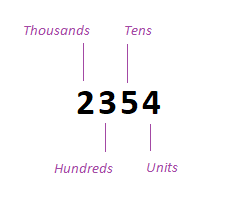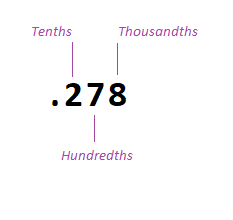1. Numbers after Decimal Point
2. Infinite, Terminating, Repeating Decimals
3. Large and Small Decimal Numbers
This page will look to explain the place value of decimal numbers, along with giving a good introduction to infinite, terminating and repeating decimals in Math.
Decimal numbers in Math can have one or more digits to the right beyond the decimal point.
Numbers after Decimal Point
Consider the numbers: 2.603 5.182 7.8845
The digits to the right of the decimal point have their own place value.
Just like how the digits before the decimal point have a value.
As an example consider the decimal number 2354.278.
The whole number to the left is 2354, and each separate digit has its place.
Each place we move to the left, gets 10 times bigger than the previous place.

Moving to the right of the decimal point follows a like process.
But this time, each place as we move to the right, gets 10 times smaller than the place previous.

The number system we most commonly use today is known as the “Base 10 System”. A bit more can be seen about this system at the splashlearn website, linked here.
Infinite, Terminating and Repeating Decimals
Decimal numbers can be “infinite” or “terminating”.
An infinite decimal goes on and on after the decimal point to the right with no end point.
Where as a terminating decimal will have an end to the digits on the right at some point.
Infinite Decimal, Infinite Repeating Decimal:
It’s the case that a decimal number can have no end point after the decimal, making it an “infinite decimal”.
There are irrational numbers like π and √5, that don’t have an end to the decimal form.
So instead of writing the decimal expansion out, it’s handier to just write π or √5 instead.
Also an infinite decimal can have a repeating pattern of digits after the decimal point.
Thus being called a “repeating” or a “recurring” decimal.
The fraction \bf{\frac{1}{9}} is an example of a fraction that produces a repeating decimal.
Terminating Decimal:
Quite simply decimal numbers such as 3.405 and 4.25 seen at the beginning of the page, are “terminating” decimals.
Which means that they do have an end somewhere after the decimal point.
Large and Small Decimal Numbers
Something to pay attention to is where the odd little mistake can be made by some people, in thinking that the likes of:
3.4 and 3.04, are the same decimals, however they aren’t.
3.4 is in fact the same as 3.40, though the zero is generally left out as we don’t really need it.
and so on.
Thus in the same way that 40 is larger than 4.
3.40 or 3.4 is larger than 3.04, you just have to remember the right place value of the numbers after the decimal point.
- Home ›
- Fractions & Decimals › Decimal Numbers